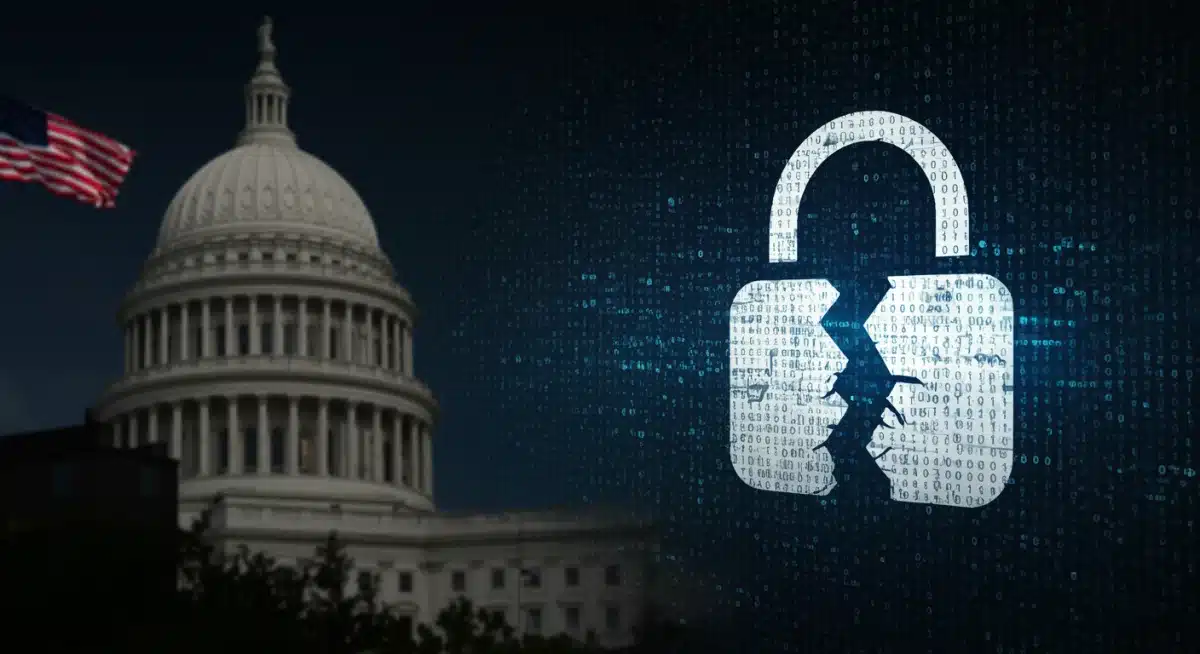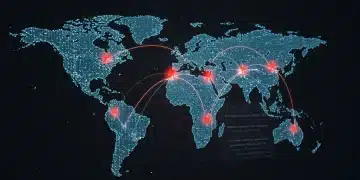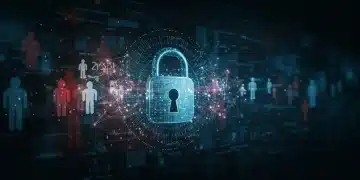Cyber Warfare 2025: 5 Global Attacks Impact US Security

Five major global cyber attacks in the last six months have significantly impacted US national security in 2025, demanding urgent practical solutions and continuous updates to safeguard critical infrastructure and data.
The landscape of global conflict is rapidly evolving, with digital battlefronts now as critical as physical ones. Cyber warfare in 2025 has emerged as a paramount concern for national security, particularly following five major global attacks in the last six months that have profoundly impacted US interests and infrastructure. This report details the implications of these recent events, offering practical solutions and highlighting recent updates critical for understanding the current threat environment.
The Evolving Threat Landscape: A New Era of Digital Conflict
The nature of warfare has undergone a seismic shift, moving beyond traditional kinetic engagements to encompass sophisticated digital assaults. In 2025, cyber attacks are not merely disruptive; they are strategic weapons capable of crippling economies, destabilizing governments, and eroding public trust. The recent surge in high-profile incidents underscores a stark reality: no nation, including the United States, is entirely immune to the pervasive and escalating threats posed by state-sponsored actors, sophisticated criminal organizations, and ideologically motivated groups.
These adversaries relentlessly probe digital defenses, exploiting zero-day vulnerabilities and human error to gain access to sensitive systems. The motives behind these attacks are diverse, ranging from espionage and intellectual property theft to direct sabotage of critical infrastructure and political interference. Understanding this multifaceted threat landscape is the first step in developing robust and adaptable defense strategies.
Key Characteristics of Modern Cyber Warfare
- Advanced Persistent Threats (APTs): Highly sophisticated, long-term attack campaigns.
- Supply Chain Attacks: Targeting software and hardware vendors to compromise downstream users.
- Hybrid Warfare: Blending cyber attacks with traditional military and disinformation tactics.
- AI-Enhanced Attacks: Leveraging artificial intelligence to automate and scale malicious activities.
The continuous evolution of attack vectors demands a dynamic defensive posture, moving beyond reactive measures to proactive threat intelligence and predictive analytics. Failing to adapt means falling behind in a race where the stakes are national sovereignty and economic stability.
Attack One: The Global Financial Network Disruption
Six months ago, a coordinated cyber attack targeted several major global financial institutions, causing widespread disruption and temporary paralysis in international transactions. This incident, attributed to a sophisticated state-sponsored group, demonstrated a clear intent to undermine economic stability and sow distrust in the global financial system. The US, heavily integrated into these networks, experienced significant fallout, including delayed transactions, compromised client data in some instances, and a temporary dip in market confidence.
Investigators, including experts from the US Cybersecurity and Infrastructure Security Agency (CISA), confirmed the attackers exploited a previously unknown vulnerability in a widely used financial transaction software. The attack was characterized by its stealth and precision, allowing the perpetrators to remain undetected for an extended period before initiating the disruptive phase. This incident highlighted the critical need for enhanced information sharing among financial entities and government agencies, as well as the imperative for continuous vulnerability assessment and patch management.
Immediate US National Security Implications
- Economic Instability: Direct financial losses and reduced investor confidence.
- Supply Chain Vulnerabilities: Exposed weaknesses in third-party financial software.
- Intelligence Gathering: Increased efforts to identify and track the responsible actors.
The attack served as a stark reminder that economic security is inextricably linked to national security. The ability to conduct commerce and maintain financial stability is fundamental to a nation’s strength, and any compromise in this domain has far-reaching consequences.
Attack Two: Critical Infrastructure Sabotage in Eastern Europe
Approximately five months ago, a series of cyber attacks crippled critical infrastructure in an Eastern European nation, causing power outages, disrupting transportation systems, and impacting essential public services. While not directly targeting the US, the incident sent shockwaves through Washington, underscoring the feasibility and destructive potential of such assaults. US intelligence agencies assessed a high probability that the same adversaries possess the capability and intent to launch similar attacks against American infrastructure.
The attack utilized highly specialized malware designed to bypass industrial control system (ICS) defenses, demonstrating a deep understanding of operational technology (OT) environments. The fallout included prolonged service interruptions, significant economic damage, and a humanitarian crisis in affected regions. This event prompted an immediate review of US critical infrastructure cybersecurity protocols and accelerated initiatives to secure energy grids, water treatment facilities, and transportation networks against similar threats.

The US Department of Homeland Security (DHS) initiated new partnerships with private sector operators to conduct joint vulnerability assessments and tabletop exercises, aiming to bolster resilience. The focus shifted to not only preventing breaches but also ensuring rapid recovery capabilities, recognizing that absolute prevention is increasingly challenging.
Attack Three: Government Data Exfiltration and Espionage
Just four months ago, a large-scale data exfiltration operation targeting multiple US government agencies was uncovered. This sophisticated espionage campaign, believed to be orchestrated by a rival global power, resulted in the theft of vast amounts of sensitive, non-classified information, including personnel records, research data, and strategic planning documents. The breach highlighted persistent vulnerabilities within government networks, despite ongoing efforts to enhance cybersecurity.
The attackers reportedly leveraged a combination of spear-phishing campaigns and zero-day exploits to gain initial access, then employed advanced lateral movement techniques to navigate undetected through various agency networks. The full extent of the compromised data and its potential long-term implications are still under assessment. However, experts warn that such information could be used for blackmail, disinformation campaigns, or to gain strategic advantages in international negotiations.
Responding to Data Exfiltration
- Enhanced Endpoint Detection: Deploying advanced tools to monitor and respond to suspicious activity.
- Zero Trust Architecture: Implementing models that verify every user and device accessing resources.
- Employee Training: Regularly educating staff on phishing awareness and secure digital practices.
This incident has spurred renewed calls for a comprehensive overhaul of government IT infrastructure and a more aggressive stance on attribution and retaliation against state-sponsored hacking groups. The integrity of government data is paramount to national security, and its compromise represents a direct threat to US strategic interests.
Attack Four: Supply Chain Compromise Affecting US Tech Sector
Three months ago, a complex supply chain attack impacted a leading US technology company, whose software is widely used across government and private sectors. The attackers managed to inject malicious code into a legitimate software update, which was then unwittingly distributed to thousands of customers, including critical US defense contractors and federal agencies. This attack demonstrated the profound vulnerability inherent in modern interconnected supply chains.
The malicious code lay dormant for weeks, designed to collect sensitive data and potentially create backdoors for future access. The discovery triggered a massive incident response effort involving both government and private sector cybersecurity teams, working tirelessly to identify affected systems and neutralize the threat. The incident caused significant financial losses, reputational damage, and forced a re-evaluation of software procurement and vendor vetting processes across the board.
This attack underscored the challenge of securing complex digital ecosystems where a single point of failure in a third-party vendor can cascade into widespread compromise. The US government is now pushing for stronger regulations and industry standards for software supply chain security, including mandatory software bill of materials (SBOM) and enhanced security auditing for all vendors.
Attack Five: Disinformation Campaign Targeting US Elections
Just two months ago, a sophisticated disinformation campaign, amplified by AI-generated content and deepfakes, targeted the US electorate ahead of crucial state-level elections. While not a direct hacking incident, this operation constituted a significant act of cyber warfare in 2025, aiming to manipulate public opinion, sow discord, and undermine democratic processes. The campaign leveraged social media platforms, compromised news websites, and advanced psychological manipulation tactics.
The use of artificial intelligence allowed the perpetrators to generate highly convincing fake news articles, audio clips, and video content at an unprecedented scale and speed. These deepfakes were nearly indistinguishable from genuine content, making it incredibly difficult for the average citizen to discern truth from falsehood. The US intelligence community explicitly attributed the campaign to a foreign adversary with a history of interfering in democratic elections.

This incident highlighted the urgent need for robust strategies to combat foreign influence operations and protect the integrity of democratic institutions. Efforts are now focused on developing AI-powered tools to detect deepfakes, promoting media literacy, and fostering greater collaboration between government agencies and social media companies to counter disinformation rapidly and effectively.
Practical Solutions and Recent Updates for US National Security
In response to these escalating threats, the US government, in collaboration with the private sector and international partners, has rolled out several practical solutions and recent updates aimed at bolstering national cybersecurity. These initiatives represent a multi-pronged approach, focusing on prevention, detection, response, and resilience. A key component is the continuous investment in advanced cybersecurity technologies, including quantum-resistant cryptography and AI-driven threat intelligence platforms, to stay ahead of evolving adversary capabilities.
Moreover, there’s an increased emphasis on human capital development, with significant funding directed towards cybersecurity education and training programs to address the critical shortage of skilled professionals. The establishment of specialized cyber commands within military and intelligence agencies signifies a more aggressive posture towards deterring and responding to digital attacks. These proactive measures are crucial in fortifying defenses against future acts of cyber warfare in 2025.
Key Initiatives and Updates
- National Cyber Strategy Implementation: Accelerating the execution of a comprehensive strategy to defend critical infrastructure and deter cyber adversaries.
- International Partnerships: Strengthening alliances for intelligence sharing and coordinated cyber defense operations.
- Zero Trust Mandates: Federal agencies are mandated to implement Zero Trust architectures to enhance internal network security.
- Critical Infrastructure Protection Programs: Expanding programs like CISA’s Joint Cyber Defense Collaborative (JCDC) to include more sectors and enhance real-time threat information sharing.
- Deepfake Detection Technologies: Investing in research and development for AI-based tools to identify and mitigate synthetic media.
These solutions are not static; they are part of an ongoing, adaptive process. The dynamic nature of cyber threats requires constant evaluation, refinement, and deployment of new strategies and technologies to maintain a defensive edge. Recent legislative actions have also provided additional funding and authority to federal agencies to enhance their cybersecurity posture and collaborate more effectively with the private sector.
Key Impact Area |
US National Security Consequence ] |
|---|---|
Financial Disruption |
Economic instability, market confidence erosion, data compromise. |
Critical Infrastructure |
Potential for power outages, transportation halts, public service disruption. |
Government Data |
Espionage, strategic disadvantage, undermined trust in government operations. |
Information Integrity |
Erosion of democratic processes, public discord, manipulation of opinion. |
Frequently Asked Questions About Cyber Warfare in 2025
Cyber warfare in 2025 is characterized by increased sophistication, AI integration, and the widespread use of supply chain vulnerabilities. Attacks are more targeted, persistent, and capable of causing physical damage or widespread societal disruption, moving beyond simple data theft to strategic sabotage.
These attacks impact US national security by exposing vulnerabilities in critical infrastructure, compromising government data, disrupting financial stability, and undermining democratic processes through disinformation. They necessitate increased defense spending and a reevaluation of national security strategies.
The US is implementing Zero Trust architectures, enhancing international intelligence sharing, investing in quantum-resistant cryptography, strengthening critical infrastructure partnerships, and developing AI-powered deepfake detection tools. Education and workforce development are also key priorities.
While state-sponsored actors pose significant threats due to their resources and strategic motives, sophisticated criminal organizations and ideologically motivated groups also contribute substantially to the cyber threat landscape. The lines between these actors are often blurred, complicating attribution.
Individuals can contribute by practicing good cyber hygiene, using strong, unique passwords, enabling multi-factor authentication, being wary of phishing attempts, and critically evaluating information to combat disinformation. Reporting suspicious activities to authorities also plays a vital role.
Impact and Implications
The series of major global cyber attacks over the past six months unequivocally demonstrates that cyber warfare in 2025 is no longer a theoretical concern but a palpable and immediate threat to US national security. These incidents have forced a critical reassessment of existing defenses and spurred accelerated development of proactive and adaptive security measures. The implications extend beyond technological fixes, touching upon geopolitical stability, economic resilience, and the integrity of democratic institutions. Moving forward, continuous vigilance, robust international collaboration, and sustained investment in both technology and human expertise will be paramount to safeguarding the nation against an ever-evolving digital adversary.





